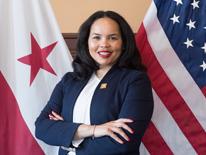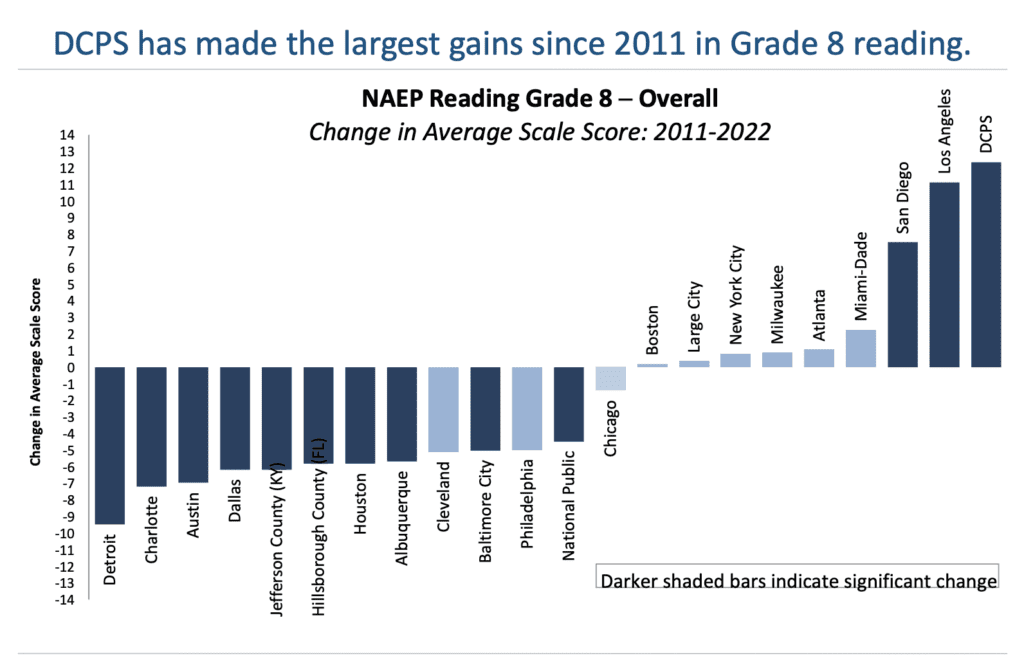Education: Some Hopeful News on D.C.’s ‘Reading Crisis’
By • January 22, 2024 0 742

Although D.C. public school students are suffering through a well-documented “reading crisis,” some hopeful signs for progress appear to be emerging on the city’s horizon.
Representing Ward 2 on the DC State Board of Education, Allister Chang, decried D.C.’s poor funding for literacy training for teachers as one of the primary factors behind D.C.’s poor performance in 4th-grade reading skills as measured by the National Association for Education Progress (NAEP) – “the nation’s report card” – even prior to the pandemic, in their report of 2019.
Shockingly, close to 70 percent of D.C.’s public school fourth-grade students tested non-proficient in grade-level reading skills that year.
“D.C. continues to lag behind, with only 30 percent of fourth-graders testing proficient or better on the 2019 NAEP reading assessment,” he wrote in the DC Line on May 9, 2022. These scores put D.C. at 47th in the nation for reading skills that year. Chang, expressed shock that even Mississippi – ranked worst-in-the-nation in NAEP reading scores – at least dedicated full funding to train all public school teachers in “structured literacy training,” while in D.C. only 1 percent of teachers were allotted such paid literacy-training opportunities.

Allister Chang represents Ward 2 on the DC State Board of Education. Courtesy DCLine/Allister Chang.
For Chang, the spillover effects of student illiteracy or poor reading performance render dire social effects. All students must learn to read by at least the 3rd grade, Chang believes. “Those who don’t achieve this milestone are more likely to drop out of high school and have a lower future earning potential.” And, obviously, such negative educational impacts are likely to correlate with other social variables such as intergenerational poverty, crime, etc.
Under Mayor Bowser and with D.C. Council support, however, some key initiatives toward improved reading performance in DC Public Schools have been launched.
“A limited number of D.C. teachers now have access to city-funded structured literacy training” through DC Public School’s DC Reading Clinic…” Chang wrote. And the “Office of the State Superintendent of Education (OSSE) recently launched a program to award about 80 educators with a $1200 stipend to complete … Language Essentials for Teachers of Reading and Spelling (LETRS) training.”
Ward 2 Council member Brooke Pinto has also helped the D.C. Council approve and fund, with the mayor’s support, a cross-agency Literacy Task Force designed to provide all D.C. teachers with “structured literary training” in the next 3 to 5 years.
In 2022, however, DCPS suffered more bad news following the latest 2022 NAEP report. “Sobering Data: National Scores in DC Area Depict Widening Achievement Gap,” WTOP news reported Oct. 24, just days after the reports’ release. In 2022, D.C. reported an 8-point decline in fourth grade reading, WTOP reported.
Despite, the drop in performance over the pandemic, however, D.C.’s public school reading trajectory appears, remarkably, to be looking up over the long term. According to the Trial Urban District Assessment (TUDA) which relies on the NAEP, the 2022 NAEP report actually shows that “DCPS is maintaining its trajectory as a rapidly improving urban school district, despite the COVID-19 pandemic and a shift to distance learning that spanned two school years,” per WTOP.
The OSSE also lauded D.C.’s improved performance in the 2022 NAEP Report. On Oct. 24, the office issued a press release acknowledging that fourth-grade reading results were disappointing — but understandable given the pandemic and nationwide learning-loss trends. However, the 8th grade reading scores, the press release said, were actually very positive news for the District’s continued improvements in teaching reading skills. “DC’s steady performance on 8th grade reading is a national bright spot,” OSSE said, compared to the “33 states [which] saw declines and the national average dropp[ing] 3 points.”
“The District’s results on NAEP further confirm the significant impact the pandemic had on student learning in our city and across the nation,” said State Superintendent Dr. Christina Grant. “The investments and policy choices made by the Bowser Administration over the past eight years have led to steady improvements, and they will be key to our recovery. The District acted quickly to plan and implement a robust recovery and restoration plan, which includes investing nearly $1 billion of federal stimulus funds to support the recovery and restoration of the public education and child care sectors.”

Dr. Christina Grant is the State Superintendent of Education for the Office of the State Superintendent of Education. Courtesy OSSE.
“OSSE’s multi-year investment of nearly $40 million into high-impact tutoring to accelerate learning and address the interrupted learning during Covid has engaged almost 2,200 students in FY22, with an anticipated 4,000 students participating in FY23,” the press release said. “OSSE will provide high-impact tutoring services to more than 8,000 students in the 2022-23 and 2023-24 school years.”
“We should not lose sight of the fact that we have closed the gap with other states over time and we can continue to do so with the strategic investments we have in place to accelerate learning,” said Grant. “These results further reinforce that in-person learning is best for most students, and we are grateful for the city’s continued commitment to improving educational outcomes in all eight wards.”
A closer look at the 2022 NAEP results for D.C. in reading scores indicates that the District’s trend line indeed improved markedly over the last 20 years.
In 2002, only 10 percent of District students scored at or above “NAEP Proficient,” while 32 percent scored as well in 2022. Per the NAEP report, the District’s most recent NAEP performance outshone such cities as Los Angeles, Albuquerque, Atlanta, Chicago, Cleveland, Milwaukee, Philadelphia and a host of other major cities, and was deemed “on par” with Boston, Charlotte, Denver, New York and others.
And, if we’re reading correctly, the following graphs from the 2022 NAEP report also confirm D.C.’s rising reading scores on The Nation’s Report Card:




